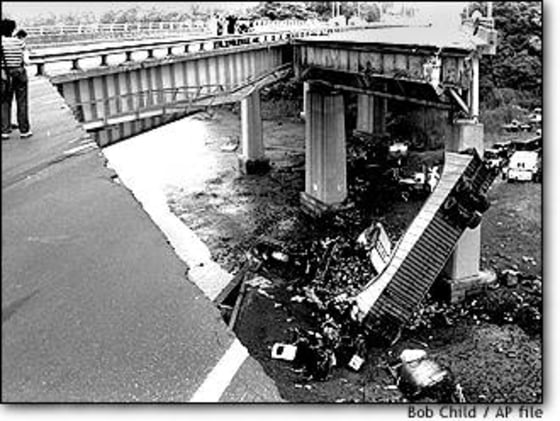On a dark summer night 20 years ago, Werner Albrecht was curled up with a book on his boat on the Mianus River in Greenwich, Conn., when he heard the thundering sound of a 100-foot section of Interstate 95 crashing into the river, taking several cars and trucks with it. “I looked out and I saw lights go over the bridge and I thought someone had driven off the edge of the bridge,” says Albrecht, now 80.
THREE PEOPLE DIED and three were critically injured in the June 1983 collapse, which officials later blamed on the failure of a rusted pin, part of the assembly that holds bridge girders in place. The Mianus River tragedy brought pledges of a new vigilance from state and federal officials charged with safeguarding the nation’s 600,000 bridges. But two decades later, America’s bridges remain in distress, according to engineers and safety officials who fear that such hidden problems will fail to be detected by current inspection practices as U.S. bridges continue to age.
PROBLEM BRIDGES
A recent study from The Road Information Program using data from the Federal Highway Administration’s 2002 National Bridge Inventory show that of the approximately 600,000 bridges in the nation, 28 percent are “deficient,” either significantly deteriorating or not meeting current highway design standards.
In spite of the fact that highway and bridge repair money has increased in the past decade and the number of problematic bridges has decreased 4 percent since 1995, officials say that the focus needs to be maintained because the number of bridges needing repair or replacement in the near future is still alarmingly high.
“Over the past decade a lot of the needed investment has been made,” says John Horsley, executive director of the American Association of State Highway Transportation Officials, noting that the last two highway funding authorizations have increased spending by 20 and 40 percent, respectively. But, he adds, “We still have a ways to go in growing the program to what the country really needs.”
Officials agree that the continued increase of vehicle numbers and weights is putting increased pressure on the bridges. According to data from The Road Information Program, vehicle travel increased by 28 percent between 1990 and 2000 and it is expected to increase another 50 percent by the year 2020.
USEFUL LIFE SPAN
The National Bridge Inventory Study Foundation, a non-profit organization that provides information about the condition of the nation’s bridges, produced a study in 2000 showing that more than 21 percent of the bridges are recommended for replacement.
“What we’re facing is hundreds of thousands of bridges nearing the end of their design lives,” says Scott McClure, professional engineer and director of the NBISF report. “What we can expect is for a number of these bridges to fail at the same time.”
The study reports that the majority of the bridges are in the 25- to 50-year age range. Considering the lifespan of a bridge is typically about 50 years, with an acceleration of deterioration in the last decade, bridge experts say the bridges will be facing serious necessary repairs in the near future.
“The average age of a bridge in the country is 40 years — 50 years is the average life span of a bridge without needing construction,” says Frank Moretti, director of policy and research for TRIP.
ALL ABOUT THE MONEY
The NBISF report estimates that completing all bridge repairs would cost the nation over $200 billion.
While McClure notes that the government spends only a fraction of that cost on improving the bridges each year — highway officials estimate it to be $3.5 billion from highway funding plus another estimated $5 billion from other funding sources — he says that money is tight and he knows the government is doing the best it can with what it has.
“They’re doing what they can but it’s not enough,” McClure says. “Much more needs to be done.”
Regardless of the aging bridges and increased traffic, highway officials say that it’s not likely that bridge collapses will become more frequent. Although budgets are tight, they say states do a good job of keeping up with inspections and repairs so that bridges don’t get to their breaking points.
“It’s very unlikely that a bridge is going to collapse,” says Moretti, adding that the bridges are well inspected on a regular basis.
But Moretti says the real concern is the cost of the repairs later on if the bridges are allowed to deteriorate. “For those big projects, the money’s just not there,” he says. “I do see a danger in that as these bigger needs will not go away.”
The current surface transportation bill, which includes funding for highways and bridges and expires at the end of September, has allowed for $218 billion in spending since 1998. Since the bill is up for reauthorization, the administration has proposed an increase to $247 billion for the next 6 years. But with the economy still floundering and money tight, there are no guarantees that funding will increase.
“Historically the federal government has recognized how important bridges are,” says Bill Buff, communications director for the American Highway Users Alliance. “But really, it’s a question of funding. Like everything else in life, it’s a question of the budget and what one can afford.”
In spite of increased funding over the years and a small decline in the number of deficient bridges, experts say that the nation’s bridges have been neglected for too long and the statistics showing the aging and deterioration of bridges speak for themselves.
“It should be a very serious call to action that we need to start addressing this problem,” Buff says. “I wouldn’t call this a ‘sky is falling’ crisis, but it should sound the alarm.”
